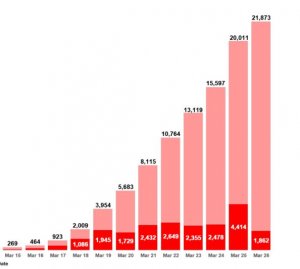usikker kunnskap, men ikke dårlig nytt om det er riktig:
«The rapidly spreading coronavirus may have already infected half the UK population — but that is encouraging news, according to a new study by the University of Oxford.
The modeling by researchers at Oxford’s Evolutionary Ecology of Infectious Disease group indicates the COVID-19 virus reached the UK by mid-January at the latest, spreading undetected for more than a month before the first official case was reported in late February, the Financial Times reports.
But even though this suggests the spread is far worse than scientists previously estimated, it also implies that only one in a thousand people infected with COVID-19 requires hospitalization.»
[…]
«This view is in contrast to the Imperial College London modeling used by the UK government to develop policies to halt the crisis, including social distancing.
“I am surprised that there has been such unqualified acceptance of the Imperial model,” Sunetra Gupta, professor of theoretical epidemiology, who led the study, told the Financial Times.»
[…]
«The group is now working with colleagues at the Universities of Cambridge and Kent to start antibody testing to figure out what stage the epidemic is in and to assess protective immunity, according to the outlet.»
https://nypost.com/2020/03/24/coronavirus-may-have-already-infected-half-of-uk-study-says/
tillegg:
se også:
https://nymag.com/intelligencer/2020/03/oxford-study-coronavirus-may-have-infected-half-of-u-k.html
[/tillegg]
omtale av den refererte studien fra oxford:
Can we trust the Oxford study on Covid-19 infections?
Adam Kucharski
This week, a preliminary study from a team at the University of Oxford gained a lot of media attention, with headlines suggesting it implied the majority of people in the UK might have already been infected with Covid-19. Few would dispute that there are more cases in the UK than already reported; our group recently published a rough analysis that suggested only 5–7% of people who’ve fallen ill with Covid-19 have been recorded as confirmed cases in the UK data. But how plausible is it that there have been millions of infections out there that were very mild (or symptomless) and went undetected?
First, let’s look at what the Oxford team actually did. Its analysis focused on deaths in the UK and Italy. If we view the data in isolation, there are several scenarios that could potentially be consistent with the observed pattern of deaths. Perhaps there are lots of infections and a low severity. Or fewer infections and a higher severity.
The Oxford researchers suggested there were multiple scenarios that could explain the deaths reported in the UK, including those in which there have been a huge number of infections that haven’t been detected. The media picked up on the most extreme of these scenarios, which implied the majority of the UK had already been infected. But remember, this analysis focused solely on deaths – and that’s not the only data we have for Covid-19.
There are now several datasets that suggest many infections come with symptoms, particularly in older groups, and hence it is less likely that there are vast numbers of infections going undetected. Such datasets include testing on the Diamond Princess cruise ship, testing of passengers on evacuation flights, the age pattern of Covid-19 cases, and infections detected among contacts of cases.
Based on these studies, it seems about 20–80% of people infected with Covid-19 could show symptoms. If this range turns out to be correct – and we combine it with our estimate that one in 15 people with symptoms are being reported – it would mean that hundreds of thousands of people in the UK have probably been infected with Covid-19 already, but not tens of millions. Of course, all these early studies have limitations in how the data was collected and what groups were being studied. To understand how much infection there has actually been, what we need are studies that collect blood samples from the wider population and test for previous exposure to Covid-19. As it happens, this was the key point made by the Oxford researchers in their paper, and it’s one I fully agree with.
There is growing evidence that, on average, people who show Covid-19 symptoms have a 1–1.5% risk of death. This has been estimated in studies of data from Wuhan, early international cases, and the Diamond Princess (with data adjusted to account for the older age of the cruise ship passengers). But this 1–1.5% risk just tells us what happens to people who have clear symptoms. If, as the above studies suggest, only 20–80% of infections come with symptoms, it would mean that for every 100,000 people who get infected with Covid-19, we would expect somewhere in the region of 200–1,200 deaths (ie between 100,000 x 20% x 1% and 100,000 x 80% x 1.5%).
We still don’t know the exact risk, and we won’t until we have the results from a large-scale analysis of blood samples. But the early pieces of information we do have suggest that this is an infection that can cause a large amount of severe disease, and the majority of the UK population are still susceptible to it. Until we have evidence to the contrary, this is the scenario we have to plan for.
• Adam Kucharski an epidemiologist and the author of The Rules of Contagion: Why Things Spread – and Why They Stop









